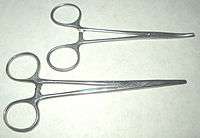Hemostat
A hemostat (also called a hemostatic clamp, arterial forceps, or pean after Jules-Émile Péan) is a surgical tool used in many surgical procedures to control bleeding.[1] For this reason, it is common in the initial phases of surgery for initial incision to be lined with hemostats which close blood vessels awaiting ligation. Hemostats belong to a group of instruments that pivot (similar to scissors, and including needle holders, tissue holders and various clamps) where the structure of the tip determines the function.

The hemostat has handles that can be held in place by their locking mechanism. The locking mechanism is typically a series of interlocking teeth, a few on each handle, that allow the user to adjust the clamping force of the pliers. When locked together, the force between the tips is approximately 40 N (9 lbf).
History
The earliest known drawing of a pivoting surgical instrument dates back to 1500 BC on a tomb at Thebes, Egypt. Later Roman bronze and steel pivot-controlled instruments were found in Pompeii. In the ninth century AD Albucasis made illustrations of pivoting instruments for tooth extraction.[2]
The concept of clamping a bleeding vessel with an instrument before tying it off is generally attributed to Galen (second century AD). This method of hemostasis was largely forgotten until it was rediscovered by the French barber-surgeon Ambroise Paré in the 16th century. He made the predecessor to the modern hemostat and called it the Bec de Corbin (crow's beak) (see image below). With it he could clamp a bleeding vessel before securing it with a ligature.
 Bec de Corbin
Bec de Corbin
The modern hemostat is credited to several persons, the foremost of which is Jules-Émile Péan. Later surgeons (i.e. William Halsted) made minor alterations to the design.
List of hemostats
- Rankin forceps[3]
- Kelly forceps
- Satinsky clamps
- Kocher forceps
- Crile forceps
- Halsted Mosquito forceps
- Mixter "right angle" forceps[4]
- Spencer Wells artery forceps[5]
See also
References
- N Phillips; P Sedlak (2010). Surgical Instrumentation. Clifton Park, New York: Cengage.
- Becker, Marshall Joseph; Turfa, Jean MacIntosh (2017). The Etruscans and the History of Dentistry: The Golden Smile Through the Ages. Taylor & Francis. p. 146.
- "Rankin, Fred Wharton". Medical Eponyms. Farlex, Inc. 2012. Retrieved 13 October 2016.
- "Mixter Forceps". Medical Eponyms. Farlex, Inc. 2012. Retrieved 13 October 2016.
- "Spencer Wells-type artery forceps". Brought to Life: Exploring the History of Medicine. The Science Museum. Retrieved 13 October 2016.
Further reading
- John Kirkup, MD, FRCS, The Evolution of Surgical Instruments - historyofscience.com